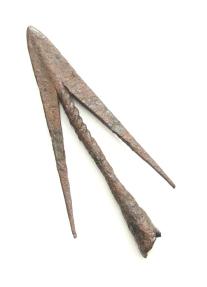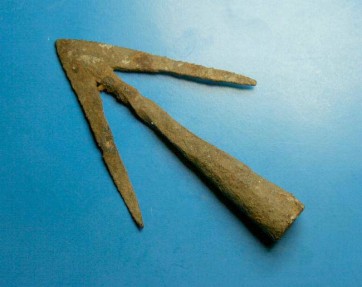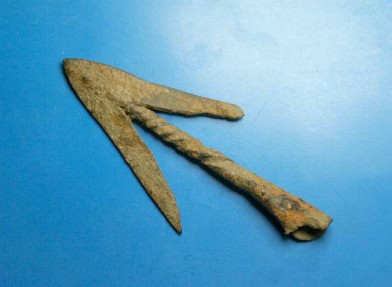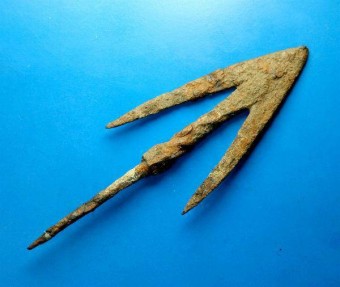
 |
|
|
#91 |
|
Member
Join Date: Nov 2012
Location: Halstenbek, Germany
Posts: 203
|
Hello Michael
Keep going - don't let it get you down! I deeply wish that your health will improve. |
|
|

|
|
|
#92 |
|
(deceased)
Join Date: Dec 2004
Location: Portugal
Posts: 9,694
|
|
|
|

|
|
|
#93 |
|
(deceased)
Join Date: Sep 2008
Location: Bavaria, Germany - the center of 15th and 16th century gunmaking
Posts: 4,310
|
Thanks a zillion, pals!
You make my return to the forum feel a whole lot like comin' home!  Best, m |
|
|

|
|
|
#94 | |
|
(deceased)
Join Date: Sep 2008
Location: Bavaria, Germany - the center of 15th and 16th century gunmaking
Posts: 4,310
|
Quote:
Hi Andi, What even Marcus most probably does not know: his quoits, just like two of some specimens in my collection, came from an old Austrian collection based in Linz/Austria; the owner, whom I knew well, sadly died some time ago. Best, m |
|
|
|

|
|
|
#95 | |
|
(deceased)
Join Date: Sep 2008
Location: Bavaria, Germany - the center of 15th and 16th century gunmaking
Posts: 4,310
|
Quote:
That's right, Andi, The outer layer always seems to have been either black tar mingled with black powder, or sulphur that turned from yellowish to a grayish white in the course of the centuries. On a couple of quoits in the Museum Nordico (City Museum) of Linz/Austria though, the wound matchcord can still be seen beneath the crumbly mixture of tar and black powder (attachments, author's photos of 1989). In the background, a bundle of matchcord for muskets is displayed, and on the right hand side there are lots of crossbow bolts, the hafts grown musty. Best, Michael Last edited by Matchlock; 11th April 2014 at 01:11 PM. |
|
|
|

|
|
|
#96 |
|
(deceased)
Join Date: Sep 2008
Location: Bavaria, Germany - the center of 15th and 16th century gunmaking
Posts: 4,310
|
Here are two of the quoits (German: Pechkränze) that came from the inventory of the old Veste (fortress) of Coburg, Northern Bavaria.
They consist of matchcord soaked in tar and wound around a wooden ring core; their diameter differs between 40 and 45 cm, the average weight is 2.5 kg. The second, smaller type of quoits attached features intertwined matchcord; at a diameter of ca 30 cm, their weight is only 500 grams. Source: Alfred Geibig: Gefährlich und schön. Coburg, 1996, p. 122f. m |
|
|

|
|
|
#97 |
|
Member
Join Date: Nov 2012
Location: Halstenbek, Germany
Posts: 203
|
Two photos of two hemp rope quoits I made at Veste Coburg two weekends ago - unfortunately I hat not mutch time to see the exhibition so I just quickly shot the photos without any preparations against the refelctions on the show case glass screens. --- I have to visit the museum again having more time for the exhibition

|
|
|

|
|
|
#98 |
|
(deceased)
Join Date: Sep 2008
Location: Bavaria, Germany - the center of 15th and 16th century gunmaking
Posts: 4,310
|
Thanks so much, Andi,
For those good photos!!! Best, Michael |
|
|

|
|
|
#99 |
|
Member
Join Date: Jun 2013
Posts: 8
|
Hi Matchlock
I wanted to run this article by you, regarding those twisted socket arrowheads: http://www.tameshigiri.ca/2014/03/14...isted-sockets/ I've come across these examples of twisted arrowheads. My organization is considering getting one of these for our traveling display of medieval antiquities, which is why I've been so curious about them. 102 mm long:  75mm long:  80mm long:  88mm long: 
|
|
|

|
|
|
#100 |
|
(deceased)
Join Date: Sep 2008
Location: Bavaria, Germany - the center of 15th and 16th century gunmaking
Posts: 4,310
|
Hi Eric,
You can of course never tell for sure when confronted with Medieval relics but in my opinion, and in all probability, these arrow shaped heads with the twisted hafts were used together with an incendiary mass. The latter would probably stick more safely on a twisted haft. Illustrated at the right-hand side of the attached photos is a crossbow bolt with its incendiary mass now missing. Best, Michael Last edited by Matchlock; 15th April 2014 at 07:19 PM. |
|
|

|
|
|
#101 |
|
Member
Join Date: Nov 2012
Location: Halstenbek, Germany
Posts: 203
|
Let me take the opportunity to post some photos of the Fire or Light Balls (in German: Feuerballen, Leuchtballen, Leuchtfässer or Sturmfässer) form the permanent exhibition of Veste Coburg, Bavaria, Germany. Please excuse the reflections on the photos as I had not much time to prevent them.
The large containers (Leucht-/Sturmfässer) on the second and third image and the 3 from the right on the fourth image, are really huge they have diameters between 27-33 cm and height ranging from 26 - 50 cm. The inner construction is a rough wooden barrel covered in a linnen fabric and overknitted with hemp ropes. The smaller Fire Balls (Image 1 and 5) have dimensions of a coconut. One is with small projectiles (German: Mordschlägen) which are missing on the other model with the visible hole. They were made of a linnen bag filled with a highly flammable mass of blackpowder, sufur, salpeter and others. They are also overknitted with hemp ropes. They are dated probably to 17th Century. Unfortunately the forums software mixed up the intended order of the images. |
|
|

|
|
|
#102 |
|
(deceased)
Join Date: Sep 2008
Location: Bavaria, Germany - the center of 15th and 16th century gunmaking
Posts: 4,310
|
Another great job, Andi,
Thanks a lot for showing these rarities! May I add the average measurements: the bigger barrels used in attacking a fortress (Sturmfässer): ca. 30-38 x 30-45 cm, the gleaming 'bulbs' (Leuchtballen): 14-17 x 16-20 cm. They most probably date from the Thirty Years War (1618-1648). Diverging from the norm, I attached an image of an exact replica of a Coburg Leuchtballen, made by Armin König, to illustrate the construction containing small grenades (Mordschläge). Quite nasty things - the terms downplaying their dangerousness ... Best, Michael Last edited by Matchlock; 18th April 2014 at 08:45 PM. |
|
|

|
|
|
#103 |
|
Member
Join Date: Nov 2012
Location: Halstenbek, Germany
Posts: 203
|
Tonight we have launched some pages about incendiary devices and grenades on our web page (Sorry that they are available in German language only but we hope get them translated into English in the near future)
http://bummsbrigade.de/cms/index.php/de/zeug/feuerwerk |
|
|

|
|
|
#104 |
|
(deceased)
Join Date: Sep 2008
Location: Bavaria, Germany - the center of 15th and 16th century gunmaking
Posts: 4,310
|
Great site, Andi,
  And perfectly researched and illustrated as well, providing tons of historic material from original sources (14th to 16th century manuscripts and books)! An exemplary and highly commendable site, also from an academic point of view! Everybody interested in early warfare and earliest firearms - GO THERE! Best, Michael |
|
|

|
|
|
#105 |
|
(deceased)
Join Date: Sep 2008
Location: Bavaria, Germany - the center of 15th and 16th century gunmaking
Posts: 4,310
|
Please see my new thread
on THE ONLY KNOWN EXISTING INCENDIARY GUN ARROW, 14th-16th century: http://www.vikingsword.com/vb/showth...ght=incendiary Best, Michael |
|
|

|
|
|
#106 |
|
Member
Join Date: May 2014
Posts: 2
|
After hearing a lot about this forum from my husband (Andi), I decided to drop in, too
 Thank you very much for all the great information and fotos in this thread (and in many others)! As a kind of introduction, I'd like to show you what we did in our backyard on sunday: Video "Burning incendiary quoit" Of course this is a reconstruction, not an original  It was only our first try, so don't expect too much - and naturally we are a little hampered by current legislations (not being allowed to simply use black powder etc.) The core was made of straw, wrapped in nitrified linnen, coated with a mixture of tar and sulfur and then coated in charcoal. Hope you enjoy it anyway! |
|
|

|
|
|
#107 |
|
(deceased)
Join Date: Sep 2008
Location: Bavaria, Germany - the center of 15th and 16th century gunmaking
Posts: 4,310
|
... sold with Sotheby's, London, in December 2004.
Best, Michael |
|
|

|
|
|
#108 |
|
(deceased)
Join Date: Sep 2008
Location: Bavaria, Germany - the center of 15th and 16th century gunmaking
Posts: 4,310
|
This large iron grenade, 18th century, diameter 21 cm, was sold for 230 Eruo plus 23 per cent commision, on May5, 2014, Hermann Historica's, Munich.
m |
|
|

|
|
|
#109 |
|
Member
Join Date: Nov 2012
Location: Halstenbek, Germany
Posts: 203
|
Our first experimental of burning a reconstructed medieval pitch garland (fire crown, quoit; German: Pechkranz) on 4. May 2014. The pitch garland was made of a ring of straw, bandaged with nitrated linnen and coated with tar and sulfur, covered by second winding of linnen with tar powdered with charcoal dust. It was built according to descriptions in medieval fireworks books such as Martin Merz: Büchsenmeisterbuch, South Germany 1420. The experiment did not meet our expectations and proved some constructional fault as it took too long until the pitch garland starts burning after igniting the match and its burning time was too long and the flames and smoke emission was too harmless.
Here a link zu a short video on youtube http://youtu.be/JRIv19BFubA The following image shows the highlit of the test. |
|
|

|
|
|
#110 |
|
(deceased)
Join Date: Sep 2008
Location: Bavaria, Germany - the center of 15th and 16th century gunmaking
Posts: 4,310
|
Hi there,
I almost forgot to introduce this very rare item that has been in my collection since the 1980's. I have not touched it for many years because is stored hidden behind my small Giech Schlänglein or Tarrasbüchse (from Latin terra, meaning earth), re-using a Nuremberg cast bronze haquebut barrel of ca. 1470 struck with the arms of the Counts von Giech. This cute early 16th century 'cannon' comes from Schloss Thurnau near Bayreuth, Franconia/Northern Bavaria, via Sotheby's in 1996. I discovered it in one of the numerous narrow but lofty 13th-14th century houses forming the Late Medieval city center of Regensburg, Bavaria. After graduating from university in 1982, I rented an apartment in an eight-storeyed 13th century house and soon started exploring both the two-storeyed cellar with its vaulted ceiling arching seven meters high, as well as the three-storeyed roof timbering where many old things were stored. One day I almost fell when stepping on a thick but rather unsound and friable plank. Beneath it, in the false ceiling there was an amorphic mass of rotten textiles, straw, mummified pidgeons and deadwood, but also a greyish stone ball with something sticking out on its top. Amazed by the weight of the thing, I carefully took out a thumb sized tapering piece that literally had no weight. It contained some dark porous stuff center and uncovered a vertical hole in the ball. At first I thought that I had found a cannon ball but when I took the stone downstairs to my flat I met the elderly couple that owned the house. They told me that I could keep the item. In my apartment, I shined a flashlight into the hole, stuck my forefinger in and when I extracted it it was covered with fine black meal powder. By then I realized that this must be a very old grenade. A few years later I read about the Thirty Years War clay grenades dug up in Ingolstadt, together with their fuses (see posts # ... and ... ), and acquired two specimens but I have never across another limestone grenade. It is especially notable for retaining its original fuse. With a weight of 3.1 kilos, it is much heavier than the Ingolstadt clay grenades and, just like them, must have been dropped down on the enemies from a house or a wall. Please also see my thread http://www.vikingsword.com/vb/showthread.php?t=12687&highlight=giech I will also post the huge iron grenade or cannon ball soon that can be seen on the photos. The sacristy cupboard on the right dates from ca. 1540; the wooden 'feet' have been shortened, and the former top piece with the Gothic crenelation is missing. Enthroned on top of the cupboard is my highly important four-barrel Landsknecht mace of ca. 1540 that comes from the world famous Samuel and Llewellyn Meyrick collection, in 1830: http://www.royalarmouries.org/about-...l-rush-meyrick http://www.vikingsword.com/vb/showth...t=meyrick+mace Best, Michael Last edited by Matchlock; 20th June 2014 at 02:15 PM. |
|
|

|
|
|
#111 |
|
(deceased)
Join Date: Sep 2008
Location: Bavaria, Germany - the center of 15th and 16th century gunmaking
Posts: 4,310
|
.
|
|
|

|
|
|
#112 |
|
Member
Join Date: Nov 2012
Location: Halstenbek, Germany
Posts: 203
|
Here are two images I made yesterday at Nuremberg Kaiserburg (Imperial Castle) Museum of fire balls used for Lustfeuerwerk (decorative fireworks) dated to 18th century. Diameter of the small balls are approx. 5-6 cm only! The large one has a diameter of approx. 8 cm height approx. 10-12 cm.
|
|
|

|
|
|
#113 |
|
Member
Join Date: Nov 2012
Location: Halstenbek, Germany
Posts: 203
|
Remains of an Ottomani fire arrow found during archaeologcial excavations of a water well at Wilhelm-Lebsaftgasse 3, 3400 Klosterneuburg, Austria in 1970. Length 383 mm max. diameter ca. 50 mm. Dated to ca. 1683. At display at Stadtmuseums Klosterneuburg, Austria.
Further info in German: http://insmuseum.com/post/2418761675...-lat-malleolus and a short one in English: http://stadtmuseum.klosterneuburg.at...d_engl_04.html |
|
|

|
|
|
#114 |
|
(deceased)
Join Date: Sep 2008
Location: Bavaria, Germany - the center of 15th and 16th century gunmaking
Posts: 4,310
|
Well done, Andi
  ! !Thanks so much for detecting, and sharing, that great 2nd half 17th c. Ottoman incendiary arrow. I have linked your post to my thread: http://www.vikingsword.com/vb/showth...621#post170621 That rare instance has been preserved at the Stadtmuseum of Klosterneuburg (museum of the City of Klosterneuburg) located at the Danube River, near Vienna, Lower Austria) ever since The Second Great Siege of Vienna by the Turks, 14 July through 12 September 1683! http://commons.wikimedia.org/wiki/Ca..._of_Vienna.png Please also cf. my thread: http://www.vikingsword.com/vb/showth...k+Suhl+Austria Best, Michael Last edited by Matchlock; 17th July 2014 at 08:49 AM. |
|
|

|
|
|
#115 |
|
Member
Join Date: Nov 2012
Location: Halstenbek, Germany
Posts: 203
|
Just found on Internet Archive:
Page 15 of American Art Association: European arms and armour, mainly XV-XVI & XVII centuries. New York : Anderson Galleries, 1928. https://archive.org/details/europeanarmsarmo00amer_0 Its funny they write that this objects were found in a castle near Switzerland (where? In Austria, Liechtenstein, Germany, Italy, or France)  and that times (1928) it is most convincable that such pitch garlands were not shown in European museums or collections, as they were not so decorative like metallic arms and armour. and that times (1928) it is most convincable that such pitch garlands were not shown in European museums or collections, as they were not so decorative like metallic arms and armour.
|
|
|

|
|
|
#116 |
|
Member
Join Date: Jun 2013
Location: Netherlands
Posts: 525
|
Two more books on the art of "feuerwerk" from 1420's and 1462. (links can be traced back to the beginning of the Ms).
http://dlib.gnm.de/item/Hs719/37/jpg/2000 http://dlib.gnm.de/item/Hs719/36/jpg/2000 http://dlib.gnm.de/item/Hs719/35/jpg/2000 http://dlib.gnm.de/item/Hs25801/35/jpg/2000 http://dlib.gnm.de/item/Hs25801/39/jpg/2000 These 2 pictures i found very interesting. The first link is that of the Grandes Chroniques de France 1332-1350 (http://www.bl.uk/manuscripts/Viewer...._16_g_vi_f181v). It shows a box with roped sticks (?) which are lit. the second link shows a page from the 1420s feuerwerkbuch with a similar roped stick. http://media-cache-ak0.pinimg.com/or...1e53aba85d.jpg http://dlib.gnm.de/item/Hs25801/46/jpg/2000 And on an unrelated note, these pictures of barrel drilling i wanted to share. http://dlib.gnm.de/item/Hs719/26/jpg/2000 (?) http://dlib.gnm.de/item/Hs719/27/jpg/2000 |
|
|

|
|
|
#117 |
|
(deceased)
Join Date: Sep 2008
Location: Bavaria, Germany - the center of 15th and 16th century gunmaking
Posts: 4,310
|
Hi Marcus,
These sources of period illustrations are really very valuable discoveries - thank you so much!!! You must have been quite busy toiling your way through all these Medieval codices for weeks, and tracing back the spare links which are hard enough to detect - though trying various key words on the Google search  ... ...Again, a great big thanks for sharing those historic treasures, and best as ever, Michl Last edited by Matchlock; 19th December 2014 at 06:02 PM. |
|
|

|
|
|
#118 |
|
Member
Join Date: Jun 2013
Location: Netherlands
Posts: 525
|
Hi Michl,
It is indeed a huge labour to leave trough all those manuscripts, hoping to find a single piece which interest us.. though very well worth it in the end  especially when complimented like this. (it must have taken me 3 hours to get trough the Historique de France) :O especially when complimented like this. (it must have taken me 3 hours to get trough the Historique de France) :O My goal for the past year has been to find even older sources than the Milemete manuscript.. evidence for guns in the late 13th and eealy 14th century (we know they should exist from written sources, but illustrations begin at 1326). I know it is a long shot but alonf the way i find many other very interesting things. |
|
|

|
|
|
#119 | ||
|
(deceased)
Join Date: Sep 2008
Location: Bavaria, Germany - the center of 15th and 16th century gunmaking
Posts: 4,310
|
Quote:
Quote:
You've been readin' my mind  , Marcus, , Marcus,That's exactly what our troublesome search is all about - and I am absolutely convinced we will detect a source of illustration earlier than the two 1326-27 de Milemete mss., and in all probability even before 1300! Powder and gun arrows must have been known, and employed, in Old Europe as well. Not only the Ancient Greek and Roman Empires used incendiary/fire arrows thousands of years ago - they were widely spread in Arabia as well. In China and Japan, people had been experimenting with incendiary and exploding stuff at least since the 13th c., and today we realize that the Vikings had landed on the North American east coast hundreds of years before Columbus and Amerigo Vespucci did. After all, the Vikings doubtlessly were the most skilled and fearless sailors of the Middle Ages; they built the best ships and had a depth of knowledge of how to navigate just guided by the stars which the rest of 13th c. Central Europeans never even dreamed of at the time. Best, Michl Last edited by Matchlock; 20th December 2014 at 12:02 PM. |
||
|
|

|
|
|
#120 |
|
Member
Join Date: Nov 2012
Location: Halstenbek, Germany
Posts: 203
|
I would interpret this image the 7 lighted sticks on the first image of the Grandes Chroniques de France 1332-1350 (http://www.bl.uk/manuscripts/Viewer...s_16_g_vi_f181v) as twisted beeswax candles made of two strings of beeswax wisted around each other. As shown on this younger illustrations from the Constance Council in 1465 showing clergymen distributing such hallowed candles or the third image of Friedrich Pacher from Brunek dated to 1480 showing St. Blasius with such a twisted candle. This type of candles is very common in the european medieval period. These images are the ones I had at hand, but there are also older images present.
And there are also exists some contemporary written sources about this special type of twisted candles. |
|
|

|
 |
|
|